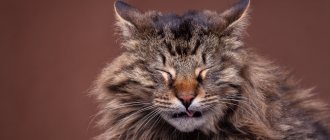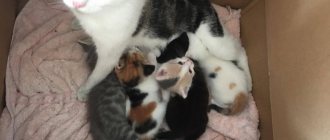Cough is a defensive reaction to external and internal irritants. In most cases, it is harmless and goes away quickly on its own. If your pet’s condition rapidly worsens, you will have to make an appointment with a veterinarian. After diagnosis, it will become clear why the cat is coughing, as if choking, and how dangerous this is for her condition. Some causes can be fatal.
What is a cough in cats?
Unlike people, cats always cough as if they are choking. It looks a little scary and strongly resembles an attack of vomiting. The animal stretches its neck, presses itself to the floor and convulses, emitting ringing or muffled sounds.
The cough reflex is triggered by receptors affected by irritants in the respiratory tract. Coughing helps get rid of foreign particles, phlegm and pus. It often accompanies respiratory diseases, and therefore requires special attention from the owner. Prolonged attacks with wheezing and discharge are a serious reason to contact a veterinarian.
Possible reasons
If your cat is coughing, you need to consider all sorts of reasons:
The causes of cough in cats and kittens can be very different. And regardless of the fact that the pet sneezes and wheezes quite rarely, with the help of this he can contribute to the functioning of the whole organism. When coughing, the throat is cleared if the kitten or cat is choking.
You can recognize a cough in a furry pet by certain movements. Typically, during this process, the pet stretches its neck down, arches its back and draws in its abdominal wall. At the same time, he wheezes, makes coughing sounds, and sometimes sneezes. In some situations, coughing is accompanied by vomiting.
After watching the video, you will learn exactly how a cat coughs.
Types of cough depending on the cause
Cough has many varieties. To treat it, it is important to identify the irritant. Depending on the cause, different associated symptoms will be observed.
Allergic
Seasonality of attacks is typical for pollen allergies. An allergic reaction is accompanied by discolored discharge from the nose, redness of the eyes, or hair loss.
Allergens also include food, fillers, household chemicals, dust, tobacco and other irritants. Try eliminating the options listed and observe the reaction.
Asthmatic
Bronchial asthma is a chronic disease of the respiratory tract. It occurs with prolonged exposure to allergens in animals over 3 years of age.
Unlike allergies, asthma attacks occur progressively. At first, the cat coughs as if she was choking, and a week later she loses consciousness and faints due to lack of oxygen. Swelling of the mucous membrane blocks the glottis and prevents normal air circulation. Pathology can be suspected based on the following signs:
- dry cough lasting more than a week;
- gradual increase in attacks;
- the appearance of shortness of breath;
- no increase in temperature;
- blueness of mucous membranes;
- increased drowsiness.
If you notice any of these symptoms, contact your veterinarian. Delay in case of bronchial asthma is unacceptable, as it can result in the death of the animal.
Viral
Colds in cats caused by hypothermia are rare. Most often, the reason that a cat is coughing as if he is choking is due to a viral infection. When infected with viruses, the symptoms are supplemented by:
- loss of appetite or complete refusal to feed;
- wheezing and vomiting;
- increased body temperature;
- lethargy and apathy;
- the appearance of serous-purulent discharge from the eyes;
- runny nose and drooling;
- formation of ulcers in the oral cavity.
Possible diagnoses include calcivirosis and rhinotracheitis. When prolonged, they lead to pneumonia, numerous ulcers and blindness. Kittens under six months of age suffer the most severe diseases - among them the mortality rate from viruses is very high.
Infection with worms
If your pet cannot cough for a long time, check it for parasites. Lungworms easily penetrate the body of even couch potatoes. They get inside an animal when it eats contaminated food or an intermediate host (mouse, insect, bird).
Inside the host's body, the parasite travels the full route, moving through the bloodstream from the intestines directly to the lungs. When re-swallowed, the cough reflex causes the worms to rush back into the small intestine, where they develop into adults. There they lay eggs, and the cycle repeats again.
Helminthiases are accompanied by:
- lethargy and apathy;
- enlarged abdomen;
- the appearance of dull and tousled fur;
- blanching of mucous membranes;
- frequent vomiting, diarrhea, bloating or belching;
- dandruff formation;
- weight loss while maintaining appetite;
- the presence of mucus, blood or parasites in the stool.
If these symptoms are detected, it is recommended to immediately consult a veterinarian. Self-medication can lead to severe intoxication of the body and death of the animal.
Foreign object or coughing up fur
Sometimes a cat coughs, as if choking, after swallowing a foreign object. Using the cough reflex, she tries to remove the stuck body from the trachea and larynx. Foreign objects entering the respiratory tract occur when:
- chewing bones or toys;
- artificial feeding through a syringe;
- regurgitation and vomiting;
- hasty eating;
- forced intake of large medications in capsule or tablet form.
Swallowing sharp or large objects increases the likelihood of internal injuries. If the object is firmly lodged in the depths of the larynx, you will have to resort to surgical intervention. Otherwise, the cat may die from suffocation.
In addition to foreign objects, the cause may lie in trichobezoars, that is, hairballs. They accumulate in the stomach after licking. One part of the lumps comes out with feces, the other dissolves in gastric juice. If there is excessive accumulation of trichobezoars, they begin to irritate the gastric walls, activating the cough reflex. You can help the animal by feeding it herbs or a special paste - then the cat will vomit hair and the cough will stop.
Why does fluffy cough?
The nature of the cough can help determine the causes. If it occurs at night, then in most situations this indicates inspiratory tracheal stenosis.
Getting rid of foreign objects
First of all, you need to figure out whether your pet is really coughing. Maybe he's just sneezing. Usually, when coughing, the fluffy makes a wheezing sound. He begins to open his mouth. Sometimes he even sticks out his tongue. It may feel like the cat is simply suffocating.
Why might a cat cough? Check his mouth and tongue. A foreign object or hairballs may get into the mouth. In order to open the mouth, insert your fingers into it in the area of the corners where there are no teeth. Open your jaws carefully, using caution.
Allergic reaction or lack of moisture
If there is nothing in the mouth, and the cat is sneezing, coughing, stretching its neck, think about whether all this could be due to an allergy. It can be caused by a new substance that has appeared in the house. Remember that allergies occur not only when you eat something, but also when you inhale it. If any item is suspicious, you need to temporarily remove it from the house.
What to do if your pet is coughing? It may simply not have enough moisture. Use humidifiers to improve your furry's breathing comfort. A damp towel, which is recommended to be placed on a working battery, will help with this.
Rid your pet of worms
As mentioned earlier, we need to figure out why the cat is sneezing and coughing. And the reason for this can be worms. In order to get rid of them, you need to purchase special products at the pharmacy and add them to your food. This action should be performed at least once a year.
Diagnostics and therapy
Before going to the veterinary clinic, try to record the characteristics of the cough that has arisen. This will help for further diagnosis. Pay attention to:
- duration (less or more than a week);
- strength (mild coughing or painful attacks);
- timbre (dull, ringing, whistling);
- presence or absence of discharge (wet or dry);
- frequency and time of occurrence.
After talking with the doctor, examining and listening to the furry patient, diagnostic tests are carried out.
These include:
- biochemical and general blood test;
- bacteriological culture;
- stool analysis;
- Ultrasound of the lungs and heart;
- bronchoscopy;
- electrocardiography;
- bronchoalveolar lavage;
- MRI;
- chest x-ray.
Until the results of all necessary tests are received, the veterinarian prescribes symptomatic treatment. It reduces the severity of attacks until the cause is determined.
Help at home
If your pet constantly regurgitates hairballs, give him a medicated paste or switch him to a special food that dissolves trichobezoars. If there is no improvement, be sure to contact your veterinarian.
In all other cases, self-medication is not allowed. Avoid symptomatic treatment before visiting a veterinary clinic. Taking medications will blur the clinical picture or worsen the animal’s condition.
Before the examination, you can relieve your pet's condition with steam inhalations. To do this, run a bath and close the bathroom. Cover the floor with a warm blanket and place the cat on it.
Avoid dry indoor conditions. Buy a humidifier and regularly ventilate the room where your sick pet lives. Beware of drafts.
During attacks, caress and calm the animal. Remember that fear will only make his condition worse. During illness, try to be nearby and not leave the cat alone.
What to do if you have wheezing
If your pet is wheezing, then you cannot delay diagnosis. The cause of wheezing depends on its nature:
- wet – accumulation of mucus in the bronchi;
- dry – obstruction of the respiratory tract due to tumors or allergic reactions;
- whistling – laryngeal edema, laryngospasm;
- creaking or crunching – bronchial asthma.
In particularly severe cases, surgery or artificial ventilation may be required to eliminate wheezing. Attempts at self-medication will not yield results, but will only accelerate the death of the animal.
Veterinarian recommendations
Individual treatment is provided for each diagnosis. If in case of infections it is logical to focus on boosting immunity, then in case of allergies this will only worsen the patient’s condition.
Allergic reactions are treated with antihistamines, which suppress the immune system. If possible, the allergen is permanently eliminated from the animal’s life.
Asthmatic cats are prescribed glucocorticoids or inhalers. Inhalation is safer, but does not always give the desired effect.
To treat viral infections, a course of antibiotics is used to destroy harmful agents. Immunity is restored with a course of immunomodulators, vitamins A and C. Symptoms are relieved with mucolytics and expectorants.
Helminthiases are eliminated with complex anthelmintic drugs. They are drunk twice. This helps to destroy not only adult parasites, but also grown larvae before laying new eggs. In case of severe dehydration and exhaustion, infusion solutions are prescribed.
If a pet chokes on a foreign object, then after removal, the damaged structures are restored. For this purpose, anti-inflammatory and wound-healing drugs are used. If a secondary infection occurs, antibiotics are prescribed.











